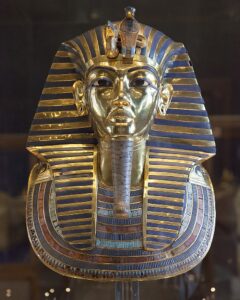Past Perfect: King Tut, I Presume? Archaeology Odyssey (5:4), Jul/Aug 2002.

Tutankhamun. By Roland Unger – Own work, CC BY-SA 3.0, https://commons.wikimedia.org/w/index.php?curid=48168958
While excavating in the Valley of the Kings, British archaeologist Howard Carter came face to face with Egyptian royalty
On November 26, 1922, British archaeologist Howard Carter (1874–1939) and his patron, the fifth Earl of Carnarvon, first glimpsed the dazzling contents of the tomb of the Egyptian pharaoh Tutankhamun (1336–1327 B.C.). Carter had arrived in Egypt nearly 30 years earlier to take a position with the Egypt Exploration Fund as an artist—a craft he learned from his father, an accomplished animal portraitist. The young man’s talents soon brought him to the attention of the most important Egyptologist of the time (perhaps of all time), the British archaeologist Flinders Petrie, who was then excavating at Tell el-Amarna. In 1899, after a brief but invaluable stint under Petrie’s tutelage, Carter was named Inspector-General of Antiquities for Upper Egypt. All this came crashing down in 1905, however, when he resigned his post rather than apologize for antagonizing a group of drunken French tourists who had harassed his workmen. For the next three years, Carter eked out a living as a commercial watercolorist and tour guide. Then, fortunately, he met Lord Carnarvon, whose interest in collecting antiquities led him to resuscitate Carter’s archaeological career—which culminated in the discovery of Tut’s tomb. When Lord Carnarvon died from a septic mosquito bite in 1923, the press was quick to dub him a victim of the “Pharaoh’s Curse.” Carter, however, was luckier- He spent the next decade cleaning and cataloguing Tut’s treasures before depositing them in Cairo’s Egyptian Museum. He then returned to England, where he died in 1939.
Read the rest of Past Perfect: King Tut, I Presume? in the online Biblical Archaeology Society Library.



